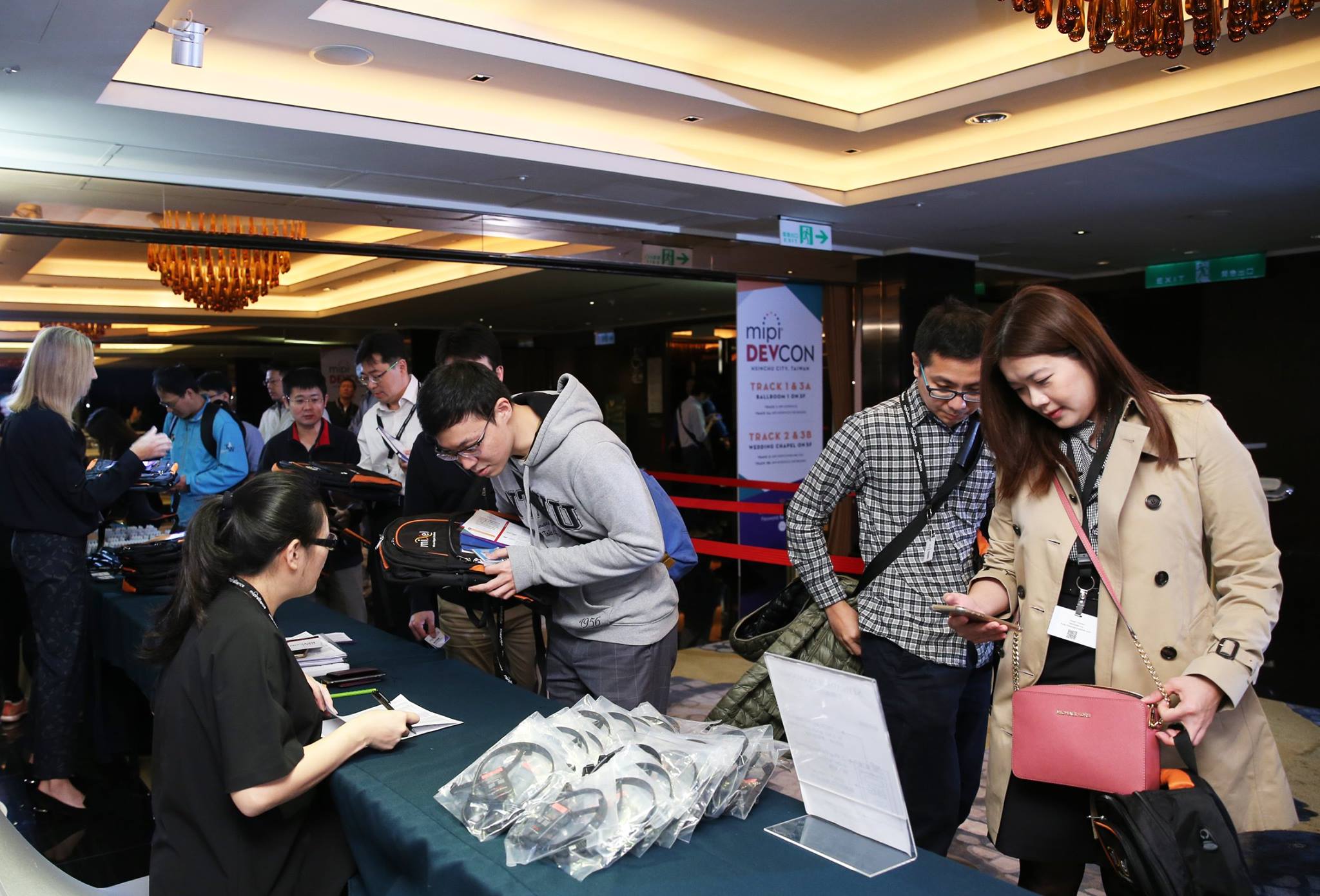Taipei 2019
Mobile & Beyond

Agenda
Click on the sessions and demos below to view the content.
18 October 2019
-
8:52 | Welcome
MIPI DevCon Chairman Soheil Modirzadeh kicked off the day by welcoming attendees to MIPI DevCon Taipei.
-
08:57 | Keynote: Technologies for Automated Driving
View the presentation slides »
Listen to the audio recording »

Evolving toward automated driving, the architecture of vehicle design is now undergoing fundamental changes, which come with the challenges of adopting new technologies, new standards, new algorithms and new regulations.
This presentation covered the mega trends of automotive, what kinds of technologies will be needed in order to realize these mega trends, and how SoC solutions with these technologies will become the foundation of automated driving systems.
Presenter:
Simon Teng received his master of engineering degree in computer science from Katholieke Universiteit Te Leuven, Belgium in 1993. He joined MediaTek in 2015 as the member of new business development focusing on automotive. Currently, he is the assistant general manager of the Intelligent Automotive Business Unit in MediaTek.
-
09:17 | State of the Alliance
View the presentation slides »
Listen to the audio recording »
 Peter Lefkin, MIPI's managing director, offered an update on MIPI's key initiatives and the latest working group activities.
Peter Lefkin, MIPI's managing director, offered an update on MIPI's key initiatives and the latest working group activities.Presenter:
Since 2011, Peter Lefkin has served as the managing director and secretary of MIPI Alliance, having returned to the role after leading the establishment of its operational support structure at its inception in 2004. In his role, Peter is the senior staff executive responsible for all MIPI Alliance activities and operations from strategy development to implementation.
-
10:07 | An Introduction to MIPI I3C v1.1 and What’s Next
View the presentation slides »
Listen to the audio recording »
 This presentation focused on the new features available in MIPI I3C® v1.1 and the efforts MIPI is taking to advance I3C for broad, long-term adoption across multiple industries and usages.
This presentation focused on the new features available in MIPI I3C® v1.1 and the efforts MIPI is taking to advance I3C for broad, long-term adoption across multiple industries and usages.Presenter:
Ken Foust is a principal engineer at Intel Corporation, where he leads wired/wireless interconnect and sensing R&D initiatives within Intel Labs. In this capacity, he also works closely with standards bodies such as MIPI, for which he serves as the chair of the I3C Working Group. Ken has been recognized with the MIPI Alliance Distinguished Service Award and as a Sensors Expo Engineer of the Year, and he is a member of the MSIG Technical Advisory Committee and Hall of Fame. Before joining Intel, Ken held many positions, including director of product engineering at Kionix, Inc., in Ithaca, N.Y. He started his career at IBM Microelectronics in Essex Junction, Vt., as a product engineer. Ken received a B.S. in electrical engineering from Alfred University.
-
10:37 | Addressing 5G RFFE Control Challenges with MIPI RFFE v3.0
View the presentation slides »
Listen to the audio recording »
 As mobile systems gear up to adopt 5G wireless specification, the RF Front-End (RF-FE) control requirements pose several challenges. The complex RF-FE architecture of 5G radios not only demands dynamic configuration changes, but also requires that the configuration changes be achieved within a much shorter time window. While MIPI RFFE℠ has served the RF-FE control requirements very well over the past decade, MIPI RFFE 3.0 aims to meet the new 5G control timing requirements and adds several enhancements to the RFFE-Trigger specification. This presentation highlighted these enhancements to triggers, aimed at meeting 5G use cases.
As mobile systems gear up to adopt 5G wireless specification, the RF Front-End (RF-FE) control requirements pose several challenges. The complex RF-FE architecture of 5G radios not only demands dynamic configuration changes, but also requires that the configuration changes be achieved within a much shorter time window. While MIPI RFFE℠ has served the RF-FE control requirements very well over the past decade, MIPI RFFE 3.0 aims to meet the new 5G control timing requirements and adds several enhancements to the RFFE-Trigger specification. This presentation highlighted these enhancements to triggers, aimed at meeting 5G use cases.Presenter:
Andrew Scott-Mackie, system engineer at Intel, has been active in wireless communications since 1998, working at companies such as Rohde & Schwarz, Alcatel-Lucent and Nokia. He currently works as a systems engineer in the Wireless RF division of Intel, with focus on control and interface aspects of RF transceivers, as well as the control of the RF front-end. Andrew is active in the MIPI RFFE working group, driving forward new features to address future control challenges, such as those due to 5G/NR. He holds a BEng degree from the University of Greenwich, England, in electrical engineering, and a master of science from the Technical University Munich in RF engineering.
-
11:22 | PHY Testing Challenges and Opportunities: The Need For a Smart Testing Approach
View the presentation slides »
Listen to the audio recording »
 Based on BitifEye's experience with testing of high-speed digital interconnect busses, this presentation highlighted the challenges observed in testing and summarized the lessons learned. Leading the A-PHY test sub team, BitifEye´s mission is to come up with a test path to make testing, and the reproducibility of the results through different test equipment vendors and interoperability workshops, easier. The goal is to lay the ground for reliable, efficient conformance test and characterization of MIPI PHYs, for example, by defining suitable test modes. The focus of this presentation was on the complex high-speed electrical PHY layer receiver conformance tests, along with transmitter, cable and protocol tests, and DUT bring-up and debugging.
Based on BitifEye's experience with testing of high-speed digital interconnect busses, this presentation highlighted the challenges observed in testing and summarized the lessons learned. Leading the A-PHY test sub team, BitifEye´s mission is to come up with a test path to make testing, and the reproducibility of the results through different test equipment vendors and interoperability workshops, easier. The goal is to lay the ground for reliable, efficient conformance test and characterization of MIPI PHYs, for example, by defining suitable test modes. The focus of this presentation was on the complex high-speed electrical PHY layer receiver conformance tests, along with transmitter, cable and protocol tests, and DUT bring-up and debugging.Presenter:
Victor Sanchez-Rico is the project manager for the MIPI test software at BitifEye, Keysight’s solutions partner for high-speed interfaces. A computer science engineer, father of three and sports car enthusiast, Victor promises to solve your testing needs while proudly showing you pictures of his daughters on his MIPI-enabled smartphone.
-
13:07 | MIPI Discovery and Configuration (DisCo) Creation Tool
View the presentation slides »
Listen to the audio recording »
 MIPI DisCo specifications define device-specific (SoundWire Master, I3C HCI, etc.) properties that are written in ACPI source language (ASL). These property keys are prescribed strings with many different value data types, often hierarchical with many layers of sub-properties. Currently these properties are written by hand using text editor. Hand-coding complex hierarchies is easy to get wrong, and current compilers do not check _DSD syntax or data types.
MIPI DisCo specifications define device-specific (SoundWire Master, I3C HCI, etc.) properties that are written in ACPI source language (ASL). These property keys are prescribed strings with many different value data types, often hierarchical with many layers of sub-properties. Currently these properties are written by hand using text editor. Hand-coding complex hierarchies is easy to get wrong, and current compilers do not check _DSD syntax or data types. The DisCo creation tool simplifies this development process by using device templates created from MIPI DisCo specifications to generate ASL files. It reduces the effort required to develop platform firmware images and time to debug firmware/software.

Presenters:
Saurin Shah has more than 14 years of experience in software development primarily focusing around the audio domain. At Microsoft, he works on developing audio class drivers for various technologies such as SoundWire, USB audio and HD audio.
The current chair of the MIPI Software Working Group, Rob Gough is a platform software architect with Intel Corporation, focusing on industry standards for operating system and firmware interfaces relating to I/O technologies and power management. He has been granted over 40 patents related in these areas and has worked with industry specification bodies including the UEFI Forum and the PCI SIG for the last 19 years. He has made many contributions to the ACPI Specification, the PCI Express Base Specification and PCI Firmware Specification and also serves as the co-chair of the PCI SIG Firmware Workgroup.
-
13:37 | Study on the Influence of Random Jitter to the MIPI C-PHY High Speed Timing Budget
View the presentation slides »
Listen to the audio recording »
 The overall timing budget for RJ (Random Jitter) and DJ (Deterministic Jittter) in MIPI C-PHY℠ is roughly defined as TX impairment, 0.15UI. The biggest contribution to the TX impairment is believed to be RJ. However, due to the unique properties of the MIPI C-PHY signal, many jitter influences are not fully studied.
The overall timing budget for RJ (Random Jitter) and DJ (Deterministic Jittter) in MIPI C-PHY℠ is roughly defined as TX impairment, 0.15UI. The biggest contribution to the TX impairment is believed to be RJ. However, due to the unique properties of the MIPI C-PHY signal, many jitter influences are not fully studied. This presentation focused on the influence of random jitters to the MIPI C-PHY high speed timing. This investigation offered a reference for MIPI C-PHY designers, and it could help the PHY working group further develop the MIPI C-PHY specification regarding the signal impairment introduced by random jitter.
Presenters:

HeeSoo Lee is the SerDes/DDR product owner in the EEsof EDA group of Keysight Technologies DES division, located in Santa Rosa, Calif. Since 1989, he has held several different positions in Keysight Technologies, Agilent Technologies and Hewlett-Packard, including consulting business manager, technical marketing lead and field applications engineer. Before that, HeeSoo worked for Daeryung Ind. Inc. as an RF/MW circuit design engineer. He has more than 30 years of design and simulation experience in the area of RF, microwave and high-speed digital designs. He graduated with a BSEE degree from the Hankuk Aviation University in South Korea.
Jingshen Liu has been a R&D software engineer with Keysight Technologies since 2018. His work focuses on SERDES and DDR high-speed channel simulations, and he developed the MIPI C-PHY℠ solution in ADS. Before joining Keysight, Jingshen received a Ph.D. in electrical engineering from the University of Houston.
-
14:22 | Next-Generation Mobile, AR/VR, & Automotive Displays with VESA VDC-M & MIPI DSI-2
View the presentation slides »
Listen to the audio recording »
 VDC-M is VESA's newest display interface compression standard. Used with MIPI DSI-2℠ transport, VDC-M offers unprecedented levels of visually lossless compression as low as 6 bits per pixel. VDC-M solves the bandwidth demand challenges associated with next-generation displays without compromising on visual quality, enabling designers to achieve higher resolutions, faster refresh rates and greater color depths than ever before. This presentation covered how the combination of VDC-M and MIPI DSI-2 can support the development of sophisticated mobile, AR/VR and automotive displays. Attendees received an overview of the VDC-M algorithm and saw concrete VDC-M and MIPI DSI-2 use cases.
VDC-M is VESA's newest display interface compression standard. Used with MIPI DSI-2℠ transport, VDC-M offers unprecedented levels of visually lossless compression as low as 6 bits per pixel. VDC-M solves the bandwidth demand challenges associated with next-generation displays without compromising on visual quality, enabling designers to achieve higher resolutions, faster refresh rates and greater color depths than ever before. This presentation covered how the combination of VDC-M and MIPI DSI-2 can support the development of sophisticated mobile, AR/VR and automotive displays. Attendees received an overview of the VDC-M algorithm and saw concrete VDC-M and MIPI DSI-2 use cases.Presenter
Alain Legault is vice president IP Products at Hardent, where he is responsible for spearheading the product definition and development of the company's IP portfolio. He has more than 25 years of experience managing multidisciplinary engineering projects and developing video-related semiconductor products. He holds a BSEE from the Polytechnique Montréal.
-
15:37 | MIPI Automotive & A-PHY Update
View the presentation slides »
Listen to the audio recording »
 Because of their key characteristics and proven performance, MIPI specifications have been deployed in billions of devices across an ever-broadening range of markets, in everything from mobile handsets, to IoT and AR/VR, to automotive. This presentation offered an overview of how MIPI specifications are being leveraged to integrate such functions as camera, displays, sensors and radio interfaces into automotive systems.
Because of their key characteristics and proven performance, MIPI specifications have been deployed in billions of devices across an ever-broadening range of markets, in everything from mobile handsets, to IoT and AR/VR, to automotive. This presentation offered an overview of how MIPI specifications are being leveraged to integrate such functions as camera, displays, sensors and radio interfaces into automotive systems.The presentation then took a detailed look at the upcoming MIPI A-PHY specification, which will bring an innovative solution for the "long-reach high-speed challenge" of connecting the highest speed electronic components throughout a vehicle. Attendees received an early look at this new physical layer specification that will work with existing MIPI specifications and others to support ADAS, autonomous driving and other surround sensor applications.
Presenters:

Matt Ronning is director of engineering at Sony Corporation and serves as chair for the MIPI Automotive Working Group. Matt is making significant steps leading the group that provides input and coordination on requirements to ensure MIPI is addressing the needs of the automotive industry.
Raj Kumar Nagpal is senior manager at Synopsys, and serves as vice chair of the MIPI PHY Working Group and chair of the A-PHY and D-PHY subgroups. Raj has more than 25 years of research and development experience in various fields of electronics, including RF engineering, high-speed serial links, signal integrity, power integrity and product validation. His work at Synopsys focuses on high-speed serial links architecture/system-level modeling, as well as signal integrity and power integrity domains of high-speed serial links. Raj has a master's of engineering degree in microwave electronics from the University of Delhi and earned his bachelor of technology degree in electronics and communication from Nagpur University.
-
16:07 | Enabling MIPI Camera Applications Including Automotive ADAS
View the presentation slides »
Listen to the audio recording »
 Synopsys discussed MIPI camera use-cases and advantages in vision-based automotive Advanced Driver Assistance Systems (ADAS) applications such as radar, LiDAR and autonomous driving. Designers can benefit from the many advantages of MIPI camera interfaces, including low-latency and high-bandwidth; however, designers must also adhere to numerous stringent automotive standards while designing their SoCs. This presentation described automotive ADAS designs with MIPI camera interface solutions such as CSI-2℠ and D-PHY℠. The presentation also outlined other MIPI automotive protocols, including I3C® and DSI℠, as well as explained the benefits of using compliant ASIL Ready, ISO 26262 certified, and AEC-Q100 qualified MIPI IP.
Synopsys discussed MIPI camera use-cases and advantages in vision-based automotive Advanced Driver Assistance Systems (ADAS) applications such as radar, LiDAR and autonomous driving. Designers can benefit from the many advantages of MIPI camera interfaces, including low-latency and high-bandwidth; however, designers must also adhere to numerous stringent automotive standards while designing their SoCs. This presentation described automotive ADAS designs with MIPI camera interface solutions such as CSI-2℠ and D-PHY℠. The presentation also outlined other MIPI automotive protocols, including I3C® and DSI℠, as well as explained the benefits of using compliant ASIL Ready, ISO 26262 certified, and AEC-Q100 qualified MIPI IP.Presenter:
Kelvin Xu is a product marketing manager for Synopsys' HDMI, mobile storage and MIPI IP solutions. He has more than 14 years of experience in the semiconductor and electronics industries, covering RTL design, FPGA system engineering, silicon validation, IP marketing and business development. Prior to joining Synopsys, Kelvin served as senior technical marketing manager for foundation IP, analog/interface IP and design services at Invecas in APAC. In addition, he spent more than seven years focusing on HDMI 1.4 to 2.1 products at Silicon Image (now Lattice). Kelvin holds a master's degree in electronics engineering from Wuhan University.
-
16:52 | New Trends in the High-Volume Manufacturing Test of MIPI-based Devices
View the presentation slides »
Listen to the audio recording »
 As more manufacturers use MIPI interfaces to enable bandwidth-intensive applications in IoT, medical and automotive sectors, we are witnessing a nascent quest to achieve zero defects per million units shipped during high-volume manufacturing. This presentation explored the latest technologies and best practices applied towards achieving that goal. It also included a summary of the fundamental requirements for quality assurance and present testing methods for very high-speed interfaces including MIPI D-PHY℠, C-PHY℠ and M-PHY ®; as well as an introduction to the concept of system-oriented testing on ATE. Throughout the presentation, practical examples of test cell design, test program development and multi-site screening techniques were provided.
As more manufacturers use MIPI interfaces to enable bandwidth-intensive applications in IoT, medical and automotive sectors, we are witnessing a nascent quest to achieve zero defects per million units shipped during high-volume manufacturing. This presentation explored the latest technologies and best practices applied towards achieving that goal. It also included a summary of the fundamental requirements for quality assurance and present testing methods for very high-speed interfaces including MIPI D-PHY℠, C-PHY℠ and M-PHY ®; as well as an introduction to the concept of system-oriented testing on ATE. Throughout the presentation, practical examples of test cell design, test program development and multi-site screening techniques were provided.Presenter:
Mohamed Hafed, Ph.D., is the chief executive officer of Introspect Technology, a leading manufacturer of innovative test and measurement products for high-speed digital applications. A passionate technology speaker and thought leader in his field, Mohamed contributes to MIPI working groups and actively participates in promoting MIPI technology worldwide.
Photos & Videos
-
Highlights videoWatch the event highlights video.
-
Event photosView event photos on Flickr.







